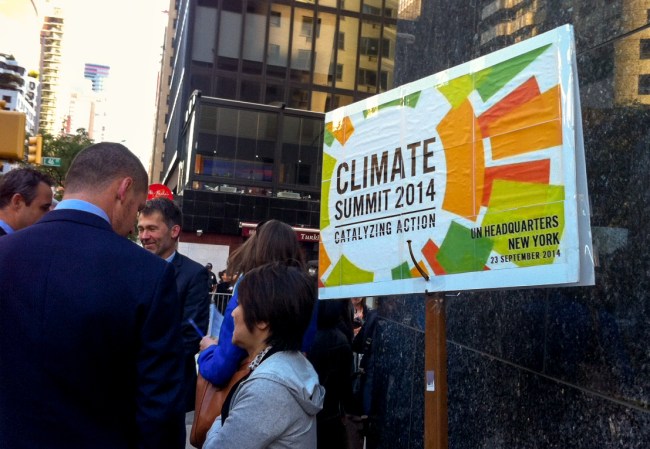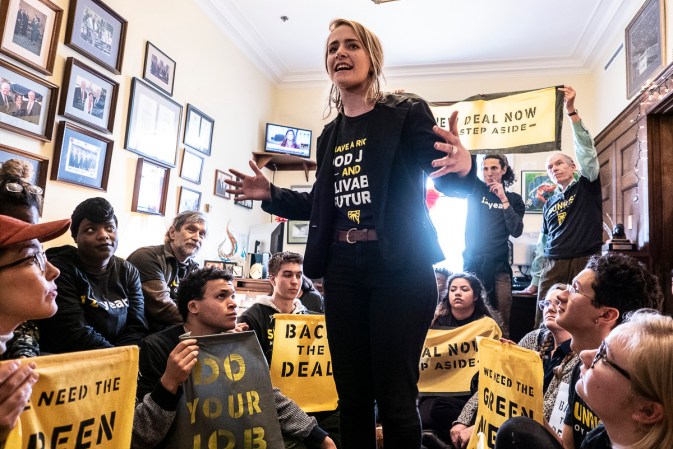

This article has been updated to reflect which candidates are still in the race.
Tomorrow, voters in 14 states will make their choice between the five Democratic presidential hopefuls: Joe Biden, Mike Bloomberg, Tulsi Gabbard, Bernie Sanders, or Elizabeth Warren. For environmentally-conscious citizens, choosing the right candidate is perhaps less than clear.
All candidates firmly oppose the myriad environmental rollbacks of the Trump Administration, which have included repealing regulations for polluting power plants, opening up public lands to oil and gas drilling, and loosening key regulations protecting wildlife and water resources (here’s a guide to all 95 environmental rules affected). They also all say they would re-enter the United States into the Paris Climate Agreement.
Figuring out where they differ is more challenging, though. Here’s where they each stand on four key topics.
The Green New Deal
All the candidates, on some level, support the goals of the Green New Deal, a 10-year mobilization to shift to a carbon-neutral economy while creating jobs and addressing environmental injustices. And all have proposed plans toward achieving net zero carbon emissions by 2050 or sooner. Some appear to be more serious in their approval than others, though.
Sanders and Warren both co-sponsored the resolution put forth by Senator Ed Markey of Massachusetts and Representative Alexandria Ocasio-Cortez of New York.
Biden also specifically call for a Green New Deal on his website. Warren and Sanders perhaps push the issue further, with promises of a massive stimulus package in their climate plans. Sanders’ has the largest price tag—$16.3 trillion—but his website says it will pay for itself in 15 years from sources including taxes and penalties obtained from the fossil fuel industry, profits from the wholesale of energy, and income tax from 20 million new jobs.
Other candidates’ support appears less enthusiastic. Gabbard has not co-sponsored the resolution, but said on her website: “I support the carbon neutrality goals of the Green New Deal.” While Bloomberg’s campaign told NPR that he’s “aligned with the climate goals of the Green New Deal,” it’s unclear whether he’s behind the resolution as a whole.
A carbon tax
A carbon tax is a relatively simplistic way to solve carbon pollution by framing it as a problem with the market. Emissions are an example of a “negative externality”—a cost that isn’t included in the price of extracting or burning fossil fuels. By requiring polluters to pay a tax on each ton of pollution (based on the estimated impact to the environment) proponents say it would reduce emissions and make the market more favorable for renewables. Biden and Bloomberg have indicated that they would pursue a carbon tax, according to the Washington Post.
Warren and Sanders both appear open to a tax as part of their larger climate strategies. However, according to the Washington Post, a Sanders campaign spokesperson said he’s opposed to a tax. Still his website says he would pay for his climate plan partly through taxes, by “Making the fossil fuel industry pay for their pollution, through litigation, fees, and tax, and eliminating fossil fuel subsidies.”
Gabbard isn’t about it. “Ultimately I don’t think that the carbon tax is the right way to get us there. Instead of passing the costs on to those who can least afford it, I will end corporate welfare to fossil fuel and nuclear power companies,” she told the Washington Post.
Nuclear power and carbon capture
Nuclear power is a divisive issue in energy policy. It can produce vast amounts of energy with no direct carbon pollution, but there are also safety concerns and the issue of toxic waste disposal. Carbon capture and storage, or CCS, includes several technologies that capture the emissions burned at power plants and sequester them in places like underground aquifers; it’s touted by some as a way to reverse climate change, but others think simply switching to 100 percent renewable energy is less expensive and more reliable.
Gabbard and Sanders are both resolutely against nuclear, according to their websites. “We know that the toxic waste byproducts of nuclear plants are not worth the risks of the technology’s benefit, especially in light of lessons learned from the Fukushima meltdown and the Chernobyl disaster,” reads Sanders’ website. “To get to our goal of 100 percent sustainable energy, we will not rely on any false solutions like nuclear, geoengineering, carbon capture and sequestration, or trash incinerators.”
Bloomberg and Warren both favor phasing out nuclear power. During CNN’s climate crisis town hall, Warren said, “We’re not going to build any nuclear power plants and we’re going to start weaning ourselves off nuclear energy and replacing it with renewable fuels.”
Biden includes nuclear power in his website’s climate plan, which describes establishing a new research agency developing “game-changing technologies.” One of these technologies would include “small modular nuclear reactors at half the construction cost of today’s reactors.” His plan also includes “capturing carbon dioxide from power plant exhausts followed by sequestering it deep underground or using it to make alternative products.”
Fracking
All candidates have said that they want to stop leases for oil and gas drilling on public lands, but their stances on fracking vary.
Gabbard, Sanders, and Warren all support a fracking ban, according to the Washington Post. Sanders and Gabbard both explicitly call for a ban on their websites, with the Sanders website saying it “must be immediately banned.”
Biden and Bloomberg have not called to end fracking. At the Nevada debate, Bloomberg said, “If we enforce the rules on fracking so they don’t release methane into the air and water, you’ll make a big difference.” Biden has also told CNN that he doesn’t support a nationwide ban on fracking.
The big picture
Overall, all candidates at least claim they can put the United States on track to meet the goals of the Paris Agreement by rapidly switching to a renewable-dominated energy system. However, some—in particular, Sanders and Warren—are committed to making that transition as part of an overall structural change to our economy, and have detailed blueprints for the overhaul they envision. To review for yourself, check out their full climate plans on their websites.























